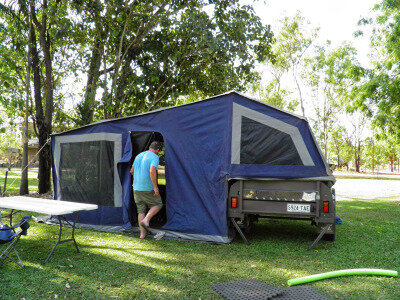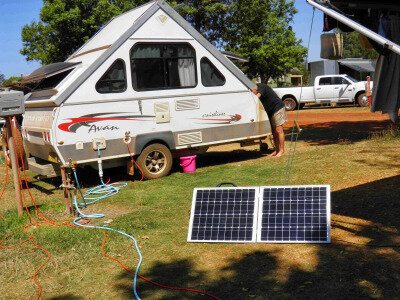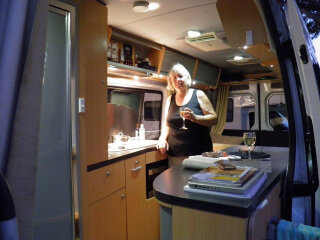A dream come true: exploring Australia by camper! It all started in a funny, unexpected way. Air Canada had an anniversary and advertised with all sorts of free flights you could win. All you had to do, was email them where and why you wanted to go to a specific place and you might win a flight there. I figured that ‘if you don’t enter you can’t win’ so I sent in an email about why I really wanted to go to Africa. Then you had to select the city where you wanted to fly and I discovered that Air Canada does not fly directly to anywhere in Africa. So I changed all the words ‘Africa’ to ‘Australia’. Within three weeks I got a reply telling me I won a free flight to Sidney, Australia…. I thought it was a hoax, a scam… But it turned out to be real!
Our home down-under for two months.
So, as soon as Kees retired from his job as parks director, we took off for three months of exploring Australia. The first time we had visited Australia, we rented a small camper van: a Toyota Hi Ace. It had clocked well over 400,000 kms and every time we made a left turn the microwave tumbled to the floor. It had no air conditioning and since you’re sitting on top of the engine in the front seat, in 40º heat, we soon had well roasted butts.
For this second, extended, trip we decided to spend a few more dollars and get a larger, newer camper wth air conditioning and a large bed. We initially booked with the Cheapa company (the name should have warned us) but when we checked reviews on Trip Advisor we found nothing but negative comments from previous users. So we changed to Britz and have been very happy with their unit and service. We used a broker to help us select the company (see www.ausandnztravel.com) Several other rental companies cater to different clientele and budgets. Make sure you check Trip Advisor before renting anything!
Where’d that tent come from?
These rental units are similar RVs to the ones you find in North America. Many class C motorhomes, small class B vans and more. The one we end up with is a Mercedes Sprinter, fully camperized.
In North America there are more and more companies which use the Mercedes Sprinter (5 cyl. diesel) to build motorhomes because it gets good mileage for such a large unit. We average 20 miles to the gallon, or about 8 liters per 100 kms. They drive well. However, when you meet one of the notorious Australian road trains (trucks that are 55 meters long and have 74 – 84 wheels) you better hang on to that steering wheel because you get hit with their draft pretty good.
Snake proof camping..
The rental companies also provide many 4×4 camper units, a good idea in Australia. Our 2 axel unit was only allowed on paved (sealed) road and as a result we had to forego visiting some National Parks or interesting sites because those would require us to travel down a dirt road. A couple of times we needed to travel 10 -12 km on unsealed roads just to get to a campground and these Sprinters are not build for rough roads, that became obvious rather quickly. Next time we visit Australia we will get a 4×4 camper. A little more expensive to drive, but at least you can get everywhere you want to go.
Camping with solar panels.
The gas (petrol) in Australia is a little more expensive, especially in the outback. You do have to be careful not to run out of gas because gas stations might be 250 km apart. There are warning signs about those infrequent services. Many people, especially those travelling dirt roads in the Outback, carry extra jerrycans with fuel.
There are several other type of RVs on the road in Australia and in campgrounds (caravan parks). First of all you see more types of trailers, or ‘caravans’ as they are called here) than we ever did see in North America. Many of them look rather low-slung when they go down the road, however as soon as they are parked a 1 or 1.5 foot pop up comes up that allows standing room in the trailer but allowed for less drag while going down the road.
Then there are the ‘camper caravans’, which we call tent trailers.
Another type we don’t see much of in North America is the ‘camper trailers’, these look like small utility trailers when being pulled behind a vehicle, but when folded out they become almost regular tents. There are a few 5th wheels and even fewer large Class A motorhomes. The big Marathon, Prevost, Country Coach, Bounder etc. that you see in North American parks are rare in Australia. You do see ‘slide on campers’ as they are called here, those are our pickup campers. And then something I have rarely seen in North America, the ‘roof top camper’. These are, usually small, tents that are carried on top of the car and which fold out, on top of the car, to a regular tent for which you need a ladder to get into it. It does keep you away from snakes and spiders, but it seems a little awkward.
Since most of Australia is well endowed with a lot of sunshine many people use solar panels to charge their aux. batteries. Since the Caravan Parks can be rather expensive (we paid between $32 and $52 for a site) many people stay in places where there are no facilities (dry camp). Especially the snowbirds (called ‘grey nomads’ or ‘silver seniors’ here) often dry camp for several days and then come into a Caravan Park for a night to replenish the drinking water, dump the grey and/or black water and get a decent shower. The facilities in these Caravan Parks are generally first class with laundromats, kitchen facilities and anything you can think of.
So.. let’s go and explore ‘down-under’. BTW did you know that the term comes from when ships in England, destined for Australia, were being loaded, people were told to go ‘down-under’, into the holds…
A cozy home on wheels.
Powered by Squarespace





